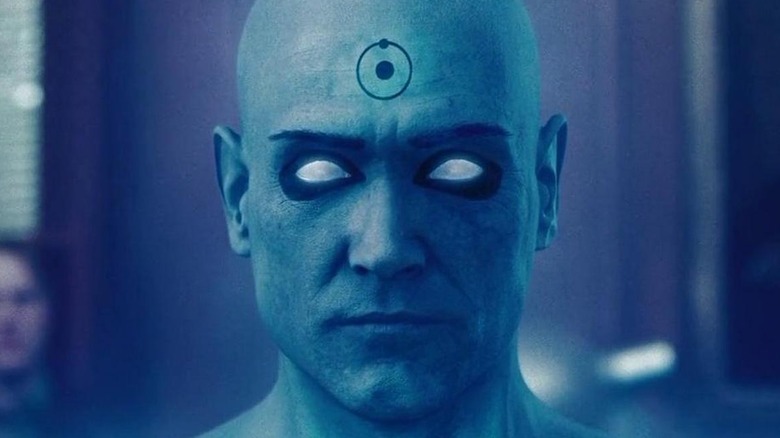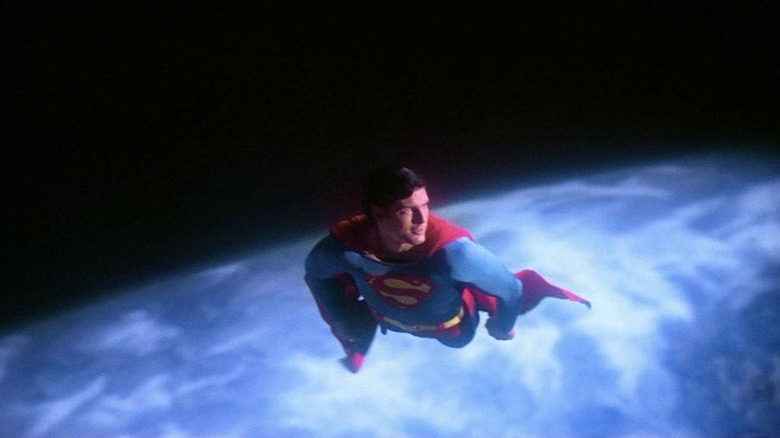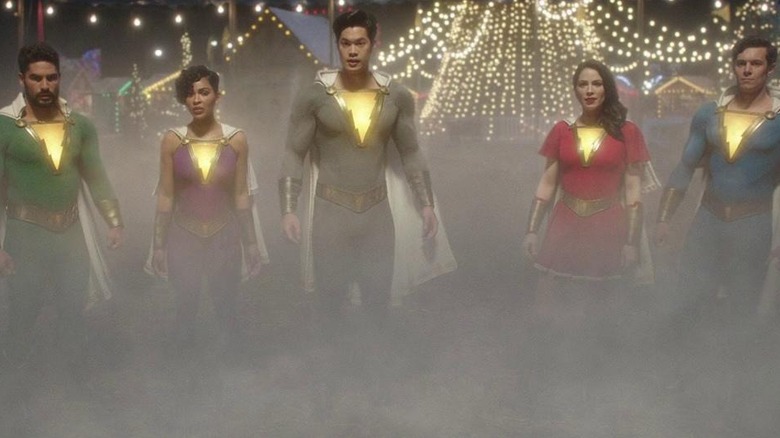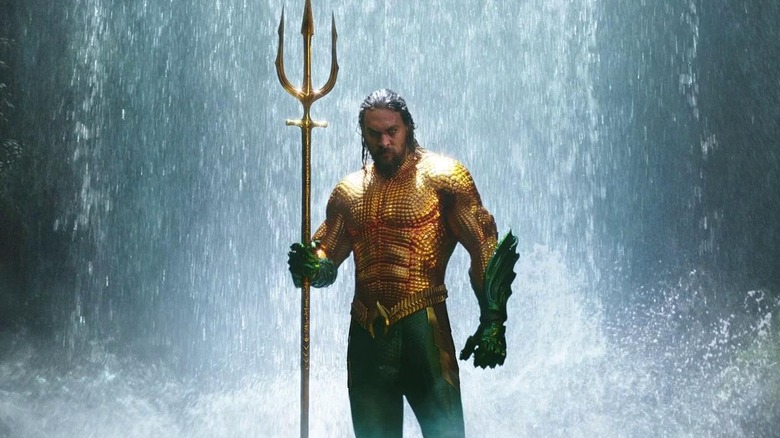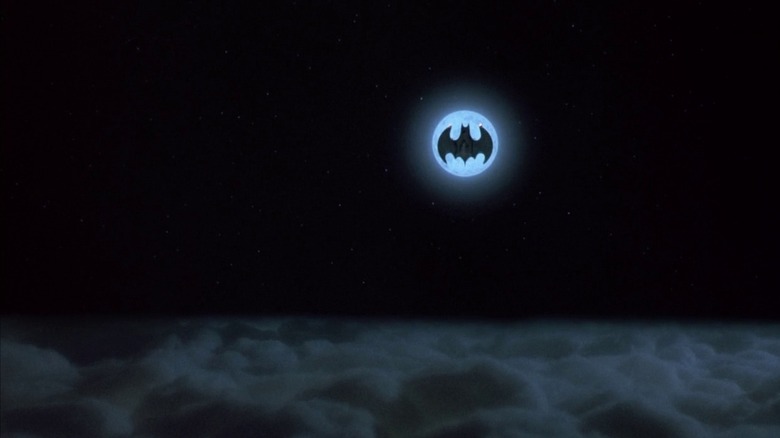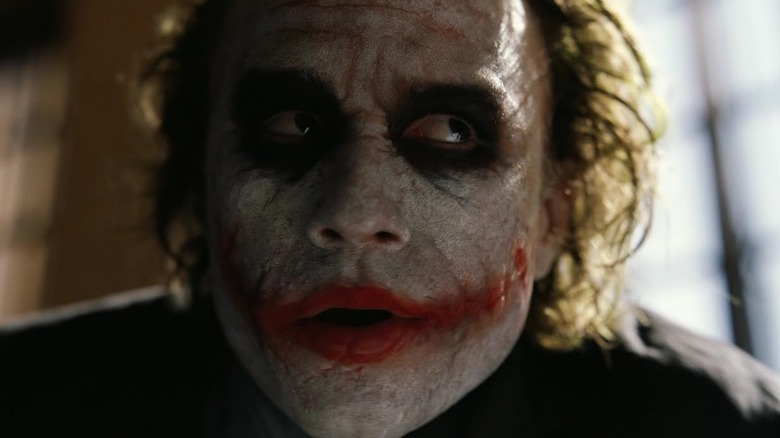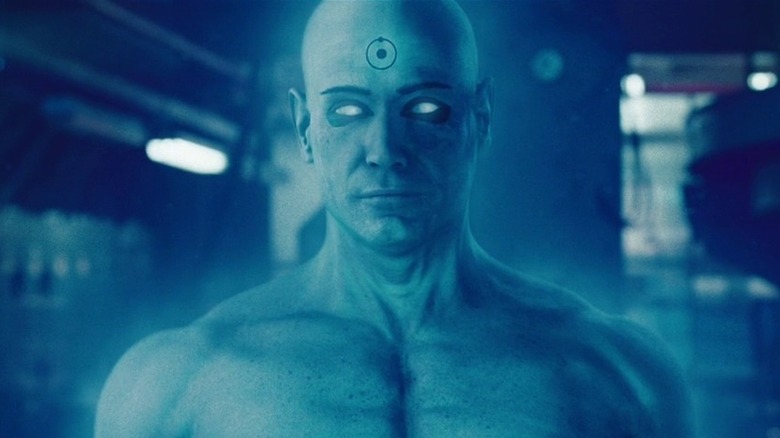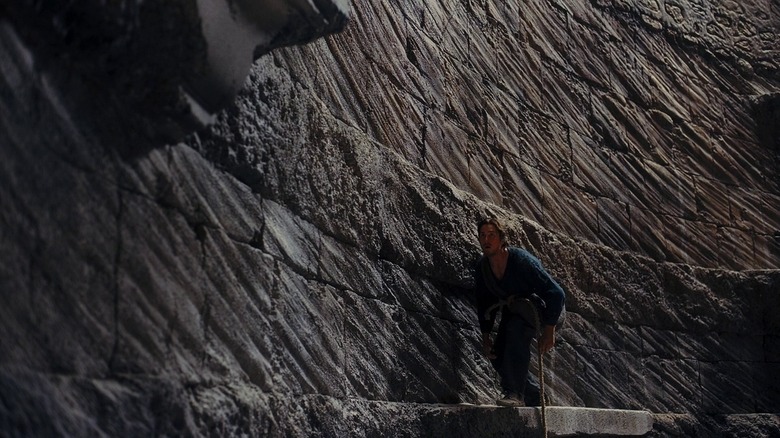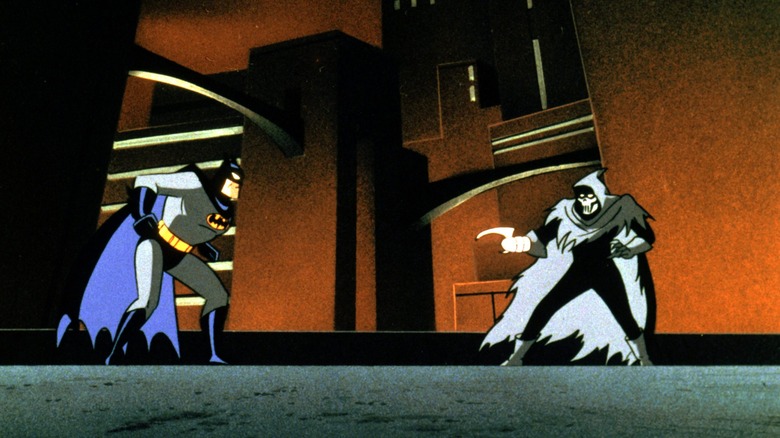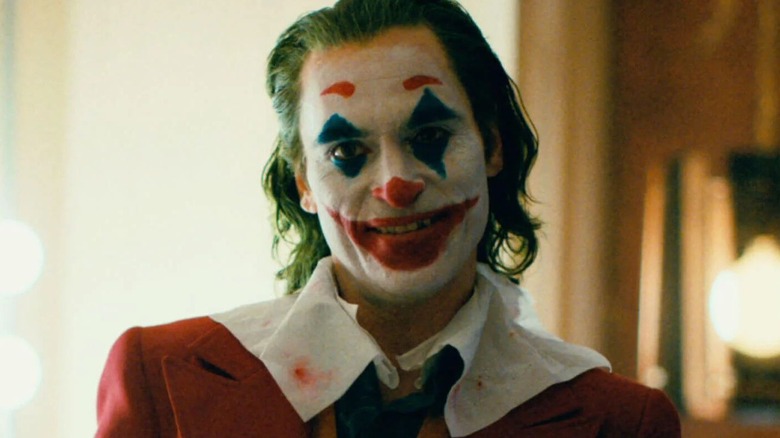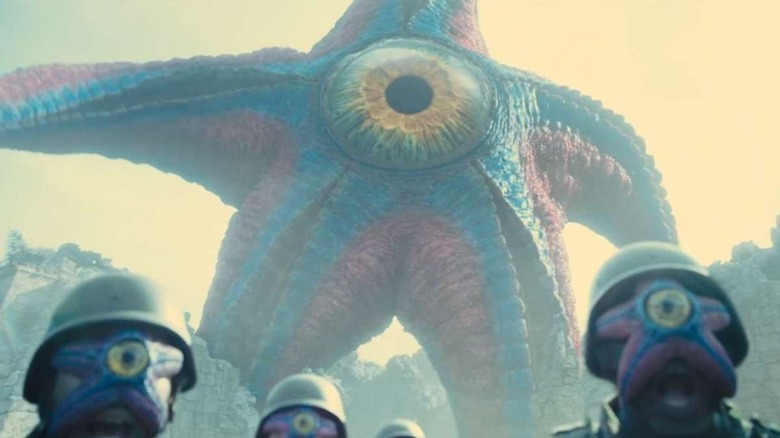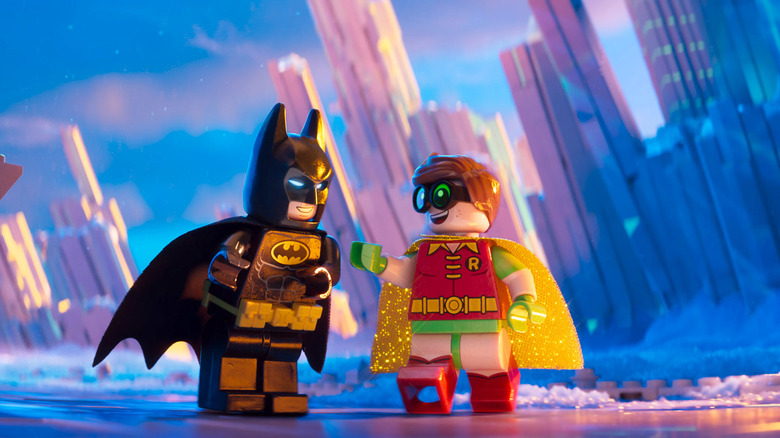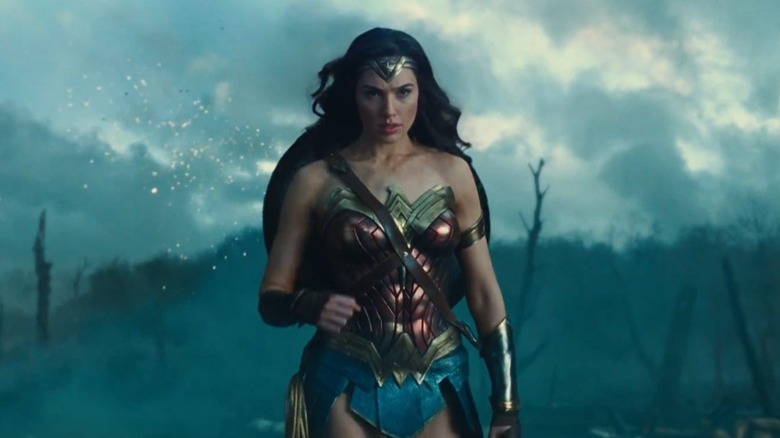DC Movie Moments That Stunned Audiences
By and large, we go to superhero movies to feel stunned. There are exceptions to this rule, but usually superhero films, big and small, are meant to instill in audiences a sense of awe in seeing something they haven't seen before. This doesn't have to be awe defined by excitement. This sensation can be defined by anything ranging from suspense to uncertainty to joy. Whatever the emotion they're intended to reflect, superhero movies tap into the most classical purposes of cinema; to create art that inspires a profound reaction from the viewer.
This sensation of being stunned has cropped up in several feature films based on characters from DC Comics. Over the various decades that these projects have been made, several individual films have delivered moments burned into the brains of moviegoers for how memorably jaw-dropping they are.
These include everything ranging from a particularly heroic moment for Wonder Woman in her first-ever live-action movie to an unforgettable montage sequence in Zack Snyder's "Watchmen" to the reveal of a larger-than-life villain in "The Suicide Squad," among many others. Watching these exhilarating moments from the history of DC Comics movie adaptations doesn't just lift one's spirits immeasurably, they also provide a reminder of the very specific wonders superhero movies can accomplish.
Superman flying for the first time in Superman: The Movie
"You will believe a man can fly." So said the posters for the very first live-action "Superman" movie. The ultimate rebuke for people who say there's no truth in advertising, this original "Superman" film did indeed make people believe that a man could zoom around in red underwear. This was especially true of a pivotal moment involving Superman's flight, occurring right after Clark Kent/Kal-El (Christopher Reeve) listens to a programmed message from his deceased father.
Hearing from Marlon Brando's Jor-El that humanity "can be a great people, Kal-El, if they choose to be" makes the stakes of this character becoming Superman and using his powers for good all the more impactful. With the underlying importance firmly established, it was time for Superman to take flight. Accompanied by that stirring theme music by John Williams, Clark Kent soars off from inside his Fortress of Solitude as Superman. It's the perfect combination of groundbreaking visual effects, music, and dialogue. Merging these elements resulted in a moment that truly did make people believe a man can fly.
The first appearance of the Shazam family in Shazam!
"Shazam!" was already working as a film with Billy Batson's grown-up title alter-ego as the only superhero on-screen. However, the increasingly personal bond developed between Batson and his assortment of adopted siblings meant that it was only inevitable that this movie would hint at the idea of these other characters taking on their own adult superhero identities as the other members of the Shazam family. However, the final of "Shazam!" took things one step further by delivering a memorably crowdpleasing moment.
As the forces of Dr. Sivana and the Seven Deadly Sins prove too daunting to face alone, Batson realizes he's going to need help. He tells his step-siblings to grasp the staff of the wizard that first granted him superpowers and say the word "Shazam." Once this is accomplished, a cloud of dust emerges and the brightly lit lightning bolts on the chests of these grown-up superheroes shine through. Batson's no longer alone: he's now got a whole crew of superhero cohorts. It's a cheer-worthy moment that director David F. Sandberg executes with a welcome sense of theatricality, but what really makes this moment work is how fulfilling it feels as a culmination of Batson's arc. Previously a loner, now he's urging others to join him in his superhero escapades. What a wonderful mix of character development and delightful comic book references.
Aquaman emerging in his comics costume in Aquaman
For many years, it looked like an "Aquaman" movie would never happen. The character, fairly or not, had turned into a punchline thanks to shows like "Entourage" and "The Big Bang Theory." The very existence, then, of a massive "Aquaman" movie in the DC Extended Universe felt like some kind of victory for those who'd always been interested in the character. The fact that the movie contained an inspiring moment where Arthur Curry/Aquaman put on his classic comic book costume for the very first time was just icing on the cake.
It would have been easy for "Aquaman" to incorporate this outfit awkwardly, just to excite comic book geeks and nobody else. Instead, the actual production used this reveal to punctuate an important confrontation between Curry and the Karathen, a mystical creature guarding a trident that our hero needs to control the seven seas so that he can stop his evil brother, Ocean Master. To reflect his commitment to being a fair ruler and fighter against the unjust, Aquaman walks out of his exchange with the Karathen clutching that trident while wearing an green-orange-and-yellow costume familiar to any comics readers. The debut of Aquaman's classic attire works here as a colorful visual manifestation of how far this superhero has come in his character arc, making it exciting for moviegoers of all stripes.
The Batwing gliding against the moon
Back in 1989, comic book movies were not something that appeared every month in movie theaters, let alone ones with real production values and polished filmmaking. So the arrival of Tim Burton's "Batman" in this era was a bolt out of the blue, a reason for celebrating. To see the Caped Crusader inhabiting such a vividly detailed project, complete with the participation of actors like Jack Nicholson, was like watching dreams come true on the silver screen. This was made all the more apparent once the finale of "Batman" arrived and delivered a truly stunning moment of excitement.
Said climax involves Batman speeding off to stop The Joker's evil plans, and to get there quickly, Batman uses the Batwing. To see this piece of equipment in a live-action movie would have been thrilling enough. But "Batman" delivers a striking moment where the Batwing soars so high up into the sky that it flies directly in front of the moon. The image of the black Batwing against the white full moon is a powerful one that reflects the heights Batman can aspire to. It's such an impressive moment that it's still imitated in movies like "Tom and Jerry" decades later. Superhero movies are more common now, but moments as impactful as this one are not.
Joker revealing his face in The Dark Knight
"The Dark Knight" wears its cinematic influences on its sleeve from the get-go thanks to a bank heist straight out of the 1990s crime movie "Heat." Even if you haven't seen that Michael Mann feature, you'll still be enthralled by this set-piece, which is remarkably well-edited and paced as the clown-masked robbers get picked off one by one. Twists big (like the sudden arrival of a school bus) and small populate this sequence, which culminates in the last robber standing taking off his mask and revealing that he's none other than Heath Ledger's Joker. The unpredictability of this supervillain is perfectly established for the rest of the film.
This final moment where the Joker reveals his identity is especially great in terms of how intimate it is. A close-up shot of Ledger's Joker fills up the entire screen and it appears as if he's talking to the audience directly as he waxes poetic on how "what doesn't kill you makes you...stranger." It's a great way to indicate to the viewer that The Joker will get in the minds of audiences and the characters of "The Dark Knight" in more personal ways. He's going to dig right into your psyche and play on your mental shortcomings rather than intimidate you with extraordinary physical strength. All those qualities are reflected powerfully at this moment, which closes out a gangbusters opening sequence on a high note guaranteed to leave moviegoers stunned.
Doctor Manhattan reflecting on his past in Watchmen
Zack Snyder's 2009 movie "Watchmen" has proved a divisive project over the years, with some viewing it as Snyder's masterpiece and others seeing it as a total hatchet job of the source material. But one thing everyone seems to agree on is how good the montage sequence depicting the origins of Jon Osterman / Doctor Manhattan (Billy Crudup) is. Lifted directly from the comics, this moment in "Watchmen" sees Osterman reflecting on his life in a fragmented manner, including his time before he got transformed into a blue-skinned being with limitless power.
While some parts of "Watchmen" didn't quite adapt as readily to the screen, this moment fit like a glove. Translating this sequence into the form of a montage helped to convey how rapidly flashes of memories float through the head of the unique new organism that Osterman becomes. The editing and Crudup's narration help to accentuate this sensation and make this rumination on Doctor Manhattan's past the most memorable moment in all of "Watchmen."
Bruce Wayne emerging from the pit in The Dark Knight Rises
Not every moment of catharsis in "The Dark Knight Rises" works as it should. For instance, the revelation that Joseph Gordon-Levitt's John Blake is actually named Robin in the film's final montage is more groan-worthy than fulfilling. But one moment in the movie that does work as intended in getting the audience to cheer is when Bruce Wayne, after so much training and learning to let go mentally, finally emerges from the Pit. Placed in this inescapable prison by Bane, Wayne's conquest of it can't help but get one's blood pumping.
The power of this moment owes much of its effectiveness to its build-up, which is told through sublime editing courtesy of Lee Smith and the use of chants from the other prisoners that escalate in intensity. These qualities make the sight of Wayne finally seeing sunlight feel as gloriously triumphant as the most exhilarating moment in any "Rocky" movie. Punctuating this moment with Wayne tossing down a rope to the other Pit prisoners adds a kindness-laced cherry on top of a thrilling moment. It's easy to critique certain moments of "The Dark Knight Rises," like that Batman/Catwoman kiss, for their awkwardness. But at least director Christopher Nolan and company crushed the execution of the moment depicting Wayne's emergence from The Pit.
Putting on the cowl for the first time in Batman: Mask of the Phantasm
Most "Batman" movies draw a straight line between Bruce Wayne taking on the Batman identity and the demise of his parents in that fateful alleyway. But leave it to the animated movie "Batman: Mask of the Phantasm" to go somewhere more psychologically complex with the idea of what triggers Wayne to don the Batman persona. Here, a failed romance between Wayne and Andrea Beaumont is shown to be as influential as anything else on this character's decision to become a superhero.
In the aftermath of Beaumont abandoning their engagement, Wayne sees no other way forward in his life but becoming a masked vigilante bent on justice. This lends a uniquely tragic quality to this iteration of the character and his decision to become Batman, one informed as much by adulthood turmoil as residual childhood trauma. Those underlying meanings come to a head in a memorable moment where Wayne puts on the Batman mask for the first time, much to the horrified astonishment of Alfred Pennyworth. The audience is just as shocked as Alfred as they watch this moment define a unique twist on Batman's origins.
Arthur Fleck killing Murray Franklin on live TV in Joker
Usually, when a life hangs in the balance in a comic book movie adaptation, it's part of a grand struggle that could involve the fate of the world. In "Joker," such a pivotal conflict emerges when Arthur Fleck (Joaquin Phoenix) shows up on talk show host Murray Franklin's (Robert De Niro) TV show. Here, the prospect of death isn't dangled over the audience before getting swept away with a positive resolution in the nick of time. Instead, this sequence climaxes with a moment where Fleck abruptly pulls out a gun and shoots Franklin in the head. It's a bold instance of violence that's over as quickly as it began, captured in a frank manner devoid of glamorization.
Even given all the gruesome violence this Joker origin story has dished out up to this point, the sudden slaughter of Franklin is one of the more disturbing moments in all of "Joker" on multiple levels, including which actor is playing the deceased Franklin. To watch a performer of Robert De Niro's stature get wiped out in such sudden fashion subtly tells the audience that nobody is safe in this vision of a world driven by chaos and little else. If the star of "Raging Bull" can bite the dust, anyone can. Combine that meta-quality of the moment with the abruptness of the violence and you're left with an indelible moment of carnage in "Joker."
The full reveal of Starro in The Suicide Squad
For a long time, the live-action DC Extended Universe movies had been defined by adherence to gritty realism. Even certain science fiction elements, such as Doomsday, had to be reworked to be byproducts of more grounded origin tales. But starting with "Wonder Woman," this norm began to get chipped away, with subsequent films like "Aquaman" and "Shazam!" working hard to emphasize a willingness to embrace the absurd. If one wanted a perfect portrait of just how far the DC Extended Universe had come in terms of accepting the ridiculous, one need only look at the first full reveal of Starro in "The Suicide Squad."
The story's primary antagonist is glimpsed throughout the film, including an early, smaller version of the character seen in old archival footage as well as a gigantic tentacle slamming against a window. Eventually, writer/director James Gunn is done teasing Starro and is ready for this otherworldly creature to be seen in all his glory. Once Starro bursts out from the ground and is seen in broad daylight, it's a truly impressive sight. It's incredible to see a version of Starro that makes no bones about being an enormous starfish, while the sheer scale of the character makes for an imposing adversary for the scrappier lead characters. It's an impressive moment guaranteed to blow audiences' minds and remind them how much modern DC films have changed in a short period of time.
Batman and cohorts charging into battle in The LEGO Batman Movie
"The LEGO Batman Movie" is, on one level, a toy commercial for kids, but it's also one of the very best "Batman" movies ever made. This accomplishment was crystalized in a moment leading right into the movie's finale, which occurs just after Gotham City is being ransacked by LEGO versions of The Joker and other famous pop culture villains, such as Voldemort and The Wicked Witch of the West. Just as all looks hopeless, LEGO Batman suddenly charges into battle, but he's not alone. He's accompanied by Robin, Batgirl, and a slew of his most famous baddies, all of them in their own ships ready to save the day.
To watch this moment is to see almost the entirety of Batman's supporting cast on-screen in one moment. There's an enjoyably giddy quality to "The LEGO Batman Movie" that makes it feel like a movie that's thrown in everything plus the kitchen sink. Nowhere is that more apparent than this moment, where the frame is just crammed with familiar faces. Plus, the upbeat undercurrent of this scene, defined by heroes and villains alike uniting forces for a bigger cause, infuses the proceedings with a joyful spirit that's infectiously endearing even if you have no idea who's who. In this stunning moment, "The LEGO Batman Movie" solidified itself as not just exceptional but, in many ways, the ultimate "Batman" movie.
Wonder Woman's trek into No Man's Land
If there was ever a moment in the history of DC Comics movie adaptations that was the very definition of "crowdpleaser," it was Wonder Woman's trek into No Man's Land in "Wonder Woman." The first time the character shows up in her iconic costume since she's left the island of Themyscira, Wonder Woman's very presence on this battlefield isn't just a rebuke of gender norms. It's also a moment that offers hope to many, including Steve Trevor, who believed that No Man's Land was impossible to cross — terrain emblematic of the hopelessness of World War I.
The sight of Wonder Woman (Gal Gadot) walking into that battlefield without a moment's hesitation is the kind of stirring image that can't help but send chills up one's spine. At this moment, Wonder Woman doesn't even need to use her sword to elicit a sense of excitement from the viewer. Her standing up to a physical embodiment of hopelessness is enough. The extra context of this moment occurring in the first big-budget superhero movie headlined by a woman only enhanced the majesty of this image. A world of new possibilities for comic book movie storytelling had opened up at this moment, possibilities that indicated these films could inspire as often as they thrill. For those who had waited for so long to see Wonder Woman on the big screen, this moment from "Wonder Woman" was a dream come true and then some.
